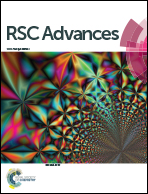Neutral plane control by using polymer/graphene flake composites for flexible displays†
Abstract
Controlling the neutral plane of a multilayer structure is crucial in designing a reliable flexible display, where the bending strain imposed on the individual layers that are positioned closer to the neutral plane can be significantly reduced. In this study, we explore the usage of polymer/graphene composites with different concentrations of graphene flakes to systematically vary the modulus in attempt to control the location of the neutral plane to the desirable position. Nanoindentation of the PMMA/graphene composite film on Si substrate revealed that increasing the graphene flake content led to the enhancement in hardness and modulus of the composite. The increased Young's modulus caused a shift in the neutral plane position towards the organic emissive layers by ∼2.2 μm that resulted in a reduction of bending strain in the organic light emitting diodes with a typical multilayer structure. Furthermore, gas permeability against O2 and water molecules showed that the gas transmission rate of PMMA/graphene composites decreased as the content of graphene flakes increased since the randomly mixed graphene in PMMA can efficiently hinder the O2 and water molecules from transporting through the thickness of the composite, thereby enhancing the barrier properties.



 Please wait while we load your content...
Please wait while we load your content...